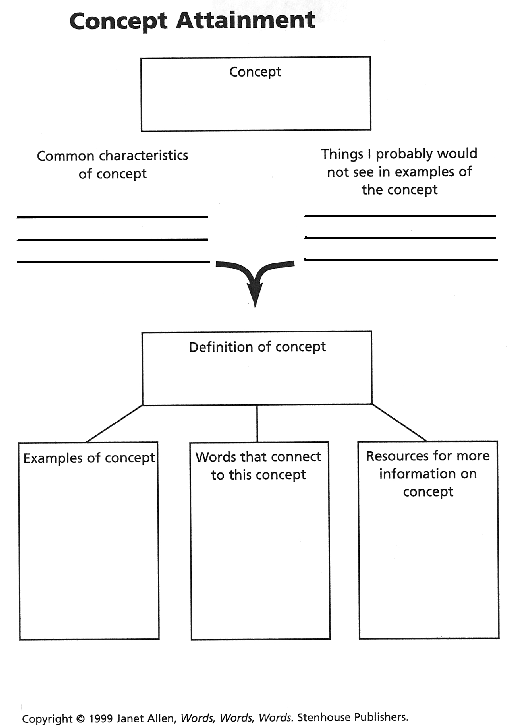47. CONCEPT ATTAINMENT (Writing, Feedback)
Description: Concept Attainment is a technique, inductive in nature, which allows students to become more independent thinkers by using hypothesis and categorization as tools for understanding.
Application: Use highly structured Concept Attainment as a guided learning opportunity for students. It can be used to introduce or conclude a unit of study.
Process: Before using this protocol in assessment, model the process with students using a basic example. Select and define a concept before beginning this activity. Create a list of attributes and develop positive and negative examples. On class day, present all of the positive and negative examples to the students without labeling them as such. Have them group the examples into the two categories and determine the essential attributes. Guide students to develop a concept definition and ask for additional examples to evaluate their understanding of the concept. Assign a final activity such as a graphic organizer (Addendum below). For more information, see http://olc.spsd.sk.ca/De/PD/instr/strats/cattain/index.html.
Description: Concept Attainment is a technique, inductive in nature, which allows students to become more independent thinkers by using hypothesis and categorization as tools for understanding.
Application: Use highly structured Concept Attainment as a guided learning opportunity for students. It can be used to introduce or conclude a unit of study.
Process: Before using this protocol in assessment, model the process with students using a basic example. Select and define a concept before beginning this activity. Create a list of attributes and develop positive and negative examples. On class day, present all of the positive and negative examples to the students without labeling them as such. Have them group the examples into the two categories and determine the essential attributes. Guide students to develop a concept definition and ask for additional examples to evaluate their understanding of the concept. Assign a final activity such as a graphic organizer (Addendum below). For more information, see http://olc.spsd.sk.ca/De/PD/instr/strats/cattain/index.html.
Reference, graphics, and/or for more information:
47. Concept Attainment
http://olc.spsd.sk.ca/De/PD/instr/strats/cattain/index.html
http://www.mindtools.com/CommSkll/ConceptAttainment.htm
47. Concept Attainment
http://olc.spsd.sk.ca/De/PD/instr/strats/cattain/index.html
http://www.mindtools.com/CommSkll/ConceptAttainment.htm

